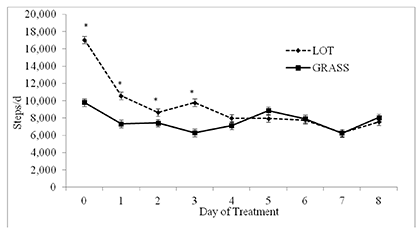Replacement Heifer Post Breeding Management
Replacement heifer's breeding season is quickly approaching and strategies to get them ready vary by operation. However, as Julie Walker, SDSU Extension Beef Specialist & SDSU Associate Professor explained, every cattle producer's goal is the same.
"Ultimately, it's about getting the heifers bred and preferably early in the breeding season," Walker said.
Following breeding, Walker said research shows increased conception rates in heifers depends upon post breeding management. "To start with, heifers should be in a body condition score of 5 or 6 and range between 55 to 65 percent of their mature weight," she said.
Research conducted at South Dakota State University provides some insight on the importance of post breeding management, especially following AI, explained George Perry, SDSU Extension Beef Reproductive Management Specialist & SDSU Professor.
"Previous research indicated that moving drylot-developed heifers to spring forage immediately after AI adversely affected average daily gain (ADG) and AI conception rates," Perry said.
However, he added that the research showed that after 27 days of grazing, there was no difference in ADG between heifers developed in a drylot and heifers developed on forage.
The research, conducted at the Antelope Research Station, reported that when heifers were moved from drylot to range, they lost weight - on average 3.5 pounds per day - during the first week. Whereas range-developed heifers gained weight - about 2 pounds per day over the same period of time.
"Heifer's grazing skills and dietary habits are acquired early in life and this learning is important to develop the motor skills necessary to harvest and ingest forage," Walker said.
Based on this, Walker recommended cattle producers allow animals to increase their consumption of grazed forage to meet nutrient needs.
Perry referenced two studies conducted at SDSU to determine the impact of adaptation to grazing on weight change and activity when heifers were moved to spring forage (Experiment 1), and whether supplementing heifers when moved to pasture following AI improved pregnancy success (Experiment 2).
Figure 1. LOT heifers were moved from the drylot to forage on first day of the treatment and GRASS heifers had been on forage for 42 days prior to the first day of treatment.
The findings
Experiment 1 was conducted to investigate if heifer development management could impact grazing behavior. Sixty-nine drylot developed heifers were randomly allotted to one of two treatments: 1) heifers remained in the drylot, or 2) heifers were moved to graze spring forage during 42 days. Daily activity was measured by steps per day.
"Heifers that were grazing spring forage took more steps per day compared to heifers in the drylot," Perry said. "However, after they were moved to spring pasture, heifers that remained in the drylot increased activity compared to those with previous experience grazing spring forage (Figure 1)." Walker added that this is significant because energy requirements increase with activity.
In the second experiment, 301 drylot-developed heifers were synchronized with the 7-day Controlled Internal Drug Releasing device (CIDR) protocol. Heifers were either moved to pasture at AI, or moved to pasture and supplemented with 5 pounds per head per day of dried distillers grain (DDGS).
Supplementation increased pregnancy success compared to non-supplemented heifers by 76 percent and 61 percent, respectively. "Thus, post breeding management can affect performance and activity," Walker said.
Management options that provide an adaption period for heifers prior to the breeding season or supplementation when heifers are moved to pasture can allow for increased reproductive efficiency.
Source: SDSU Extension







